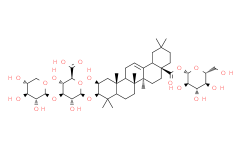Celosin KCAS# 1950579-53-9 |

Quality Control & MSDS
Package In Stock
Number of papers citing our products

| Cas No. | 1950579-53-9 | SDF | Download SDF |
| PubChem ID | N/A | Appearance | Powder |
| Formula | C47H74O19 | M.Wt | 943.08 |
| Type of Compound | N/A | Storage | Desiccate at -20°C |
| Solubility | Soluble in Chloroform,Dichloromethane,Ethyl Acetate,DMSO,Acetone,etc. | ||
| General tips | For obtaining a higher solubility , please warm the tube at 37 ℃ and shake it in the ultrasonic bath for a while.Stock solution can be stored below -20℃ for several months. We recommend that you prepare and use the solution on the same day. However, if the test schedule requires, the stock solutions can be prepared in advance, and the stock solution must be sealed and stored below -20℃. In general, the stock solution can be kept for several months. Before use, we recommend that you leave the vial at room temperature for at least an hour before opening it. |
||
| About Packaging | 1. The packaging of the product may be reversed during transportation, cause the high purity compounds to adhere to the neck or cap of the vial.Take the vail out of its packaging and shake gently until the compounds fall to the bottom of the vial. 2. For liquid products, please centrifuge at 500xg to gather the liquid to the bottom of the vial. 3. Try to avoid loss or contamination during the experiment. |
||
| Shipping Condition | Packaging according to customer requirements(5mg, 10mg, 20mg and more). Ship via FedEx, DHL, UPS, EMS or other couriers with RT, or blue ice upon request. | ||

Celosin K Dilution Calculator

Celosin K Molarity Calculator
| 1 mg | 5 mg | 10 mg | 20 mg | 25 mg | |
| 1 mM | 1.0604 mL | 5.3018 mL | 10.6036 mL | 21.2071 mL | 26.5089 mL |
| 5 mM | 0.2121 mL | 1.0604 mL | 2.1207 mL | 4.2414 mL | 5.3018 mL |
| 10 mM | 0.106 mL | 0.5302 mL | 1.0604 mL | 2.1207 mL | 2.6509 mL |
| 50 mM | 0.0212 mL | 0.106 mL | 0.2121 mL | 0.4241 mL | 0.5302 mL |
| 100 mM | 0.0106 mL | 0.053 mL | 0.106 mL | 0.2121 mL | 0.2651 mL |
| * Note: If you are in the process of experiment, it's necessary to make the dilution ratios of the samples. The dilution data above is only for reference. Normally, it's can get a better solubility within lower of Concentrations. | |||||

Calcutta University

University of Minnesota

University of Maryland School of Medicine

University of Illinois at Chicago

The Ohio State University

University of Zurich

Harvard University

Colorado State University

Auburn University

Yale University

Worcester Polytechnic Institute

Washington State University

Stanford University

University of Leipzig

Universidade da Beira Interior

The Institute of Cancer Research

Heidelberg University

University of Amsterdam

University of Auckland

TsingHua University

The University of Michigan

Miami University

DRURY University

Jilin University

Fudan University

Wuhan University

Sun Yat-sen University

Universite de Paris

Deemed University

Auckland University

The University of Tokyo

Korea University
- N-acetyldopamine dimmers A
Catalog No.:BCX0871
CAS No.:1519015-73-6
- Lugrandoside
Catalog No.:BCX0870
CAS No.:117457-37-1
- Acetyl Dopamine DimerIII
Catalog No.:BCX0869
CAS No.:916888-49-8
- α-Curcumene
Catalog No.:BCX0868
CAS No.:644-30-4
- Deacetylkadsurin
Catalog No.:BCX0867
CAS No.:51670-42-9
- Acetyl Dopamine DimerIV
Catalog No.:BCX0866
CAS No.:1632326-65-8
- Crocin E
Catalog No.:BCX0865
CAS No.:58050-17-2
- Polyporusterone C
Catalog No.:BCX0864
CAS No.:141360-90-9
- Eucomoside B
Catalog No.:BCX0863
CAS No.:951672-66-5
- (+)-5-methoxydeydrodiisoeugenol
Catalog No.:BCX0862
CAS No.:1967042-42-7
- Dieugenol
Catalog No.:BCX0861
CAS No.:4433-08-3
- 6''-Malonylthymosin I
Catalog No.:BCX0860
CAS No.:528606-92-0
- Breviscapine
Catalog No.:BCX0873
CAS No.:116122-36-2
- Demethoxydeacetoxypseudolaric acid B
Catalog No.:BCX0874
CAS No.:500736-17-4
- Quercitin-3′-O- glucofuranoside
Catalog No.:BCX0875
CAS No.:21637-25-2
- Ilexgenin B
Catalog No.:BCX0876
CAS No.:109008-39-1
- Cyanidin-3-Rutinosidechloride Cyanidin-3-Rutinoside
Catalog No.:BCX0877
CAS No.:28338-59-2
- Cyanidin3-O-2G-glucosylrutinoside
Catalog No.:BCX0878
CAS No.:755695-57-9
- Delphinidin-3-O-arabinoside
Catalog No.:BCX0879
CAS No.:28500-01-8
- Delphinidin-3-Rutinoside Delphinidin-3-Rutinosidechloride
Catalog No.:BCX0880
CAS No.:58285-26-0
- GalantamineHydrobromide
Catalog No.:BCX0881
CAS No.:69353-21-5
- (+)-Medicarpin
Catalog No.:BCX0882
CAS No.:33983-40-3
- Benzoylalbiflorin
Catalog No.:BCX0883
CAS No.:184103-78-4
- Allosecurinin
Catalog No.:BCX0884
CAS No.:884-68-4
Dereplication-guided isolation of novel hepatoprotective triterpenoid saponins from Celosiae Semen by high-performance liquid chromatography coupled with electrospray ionization tandem quadrupole-time-of-flight mass spectrometry.[Pubmed:27721071]
J Pharm Biomed Anal. 2017 Jan 5;132:148-155.
Although natural products (NPs) from ethnomedical plants have played a vital role in modern drug discovery, separation and purification of bioactive compounds from plant extract is still challenging. In this study, a dereplication strategy using HPLC-QTOF-MS was employed to rapidly discover and highly targeted isolate the novel hepatoprotective triterpenoid saponins from the methanol extract of Celosiae Semen. Firstly, four known saponins, i.e. celosin H, celosin I, celosin J, and pseudoginsenoside RT1 were selected as model compounds, and their fragmentation patterns in ESI-QTOF-MS/MS were characterized. Secondly, an HPLC-QTOF-MS/MS method was applied to chemically screen the saponins of interest, and thereby to guide the subsequent fraction and isolation procedure. Thirdly, the targeted isolation of desired compounds afforded two new triterpenoid saponins namely Celosin K (1) and celosin L (2), which were structurally elucidated by combination of extensive NMR spectroscopic and chemical analyses. Finally, the protective effects of compounds 1 and 2 against APAP-induced hepatotoxicity in HepG2 cells were evaluated. These results indicate that the HPLC-QTOF-MS-guided isolation is an efficient methodology for isolating new NPs from medicinal plants through improving selectivity in separation and purification process.


